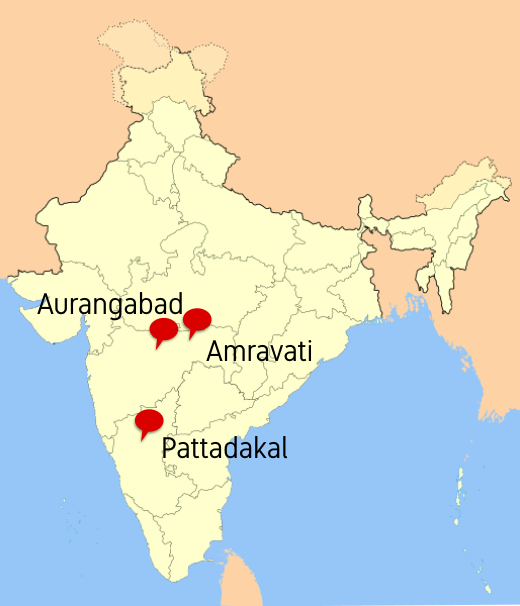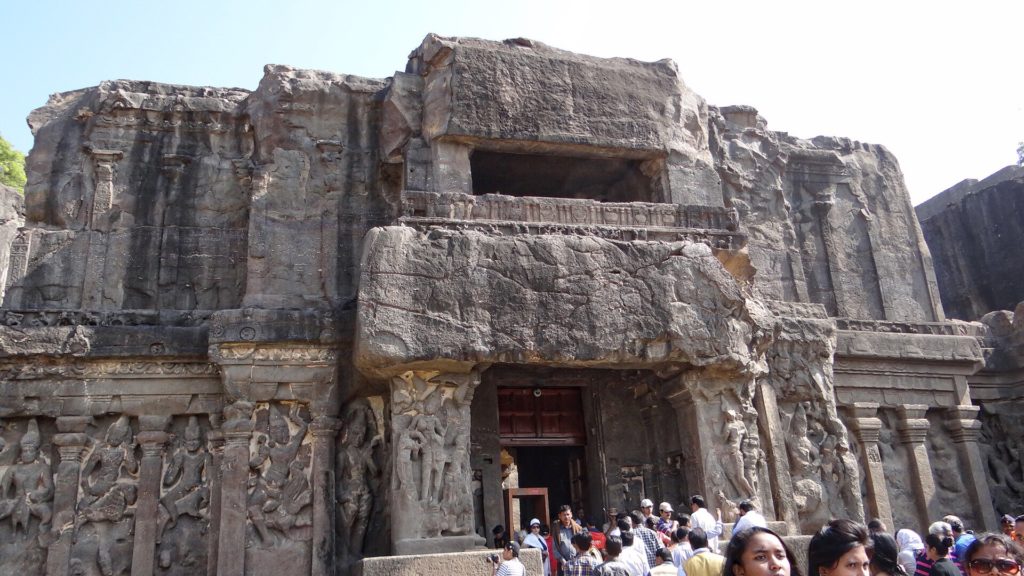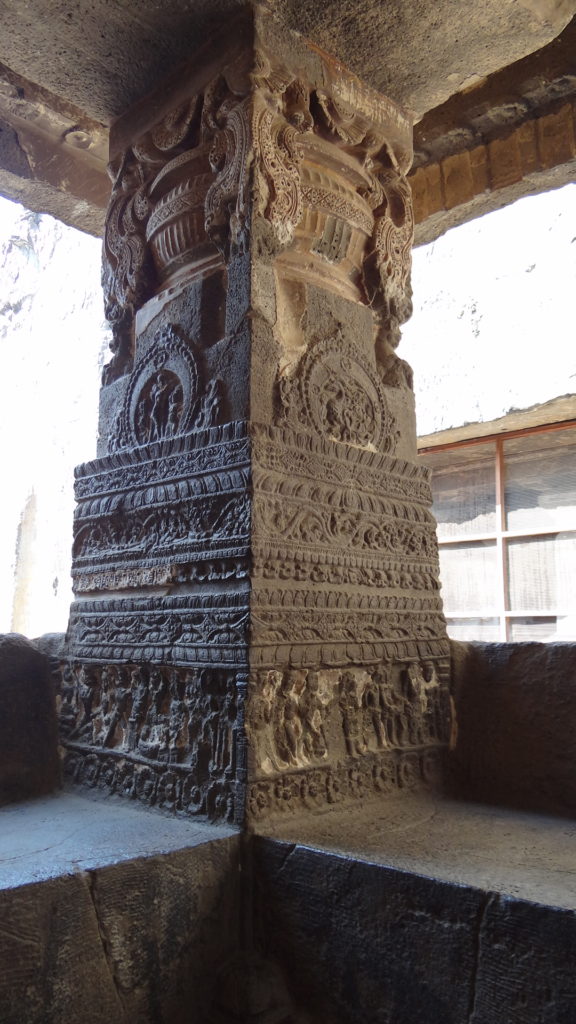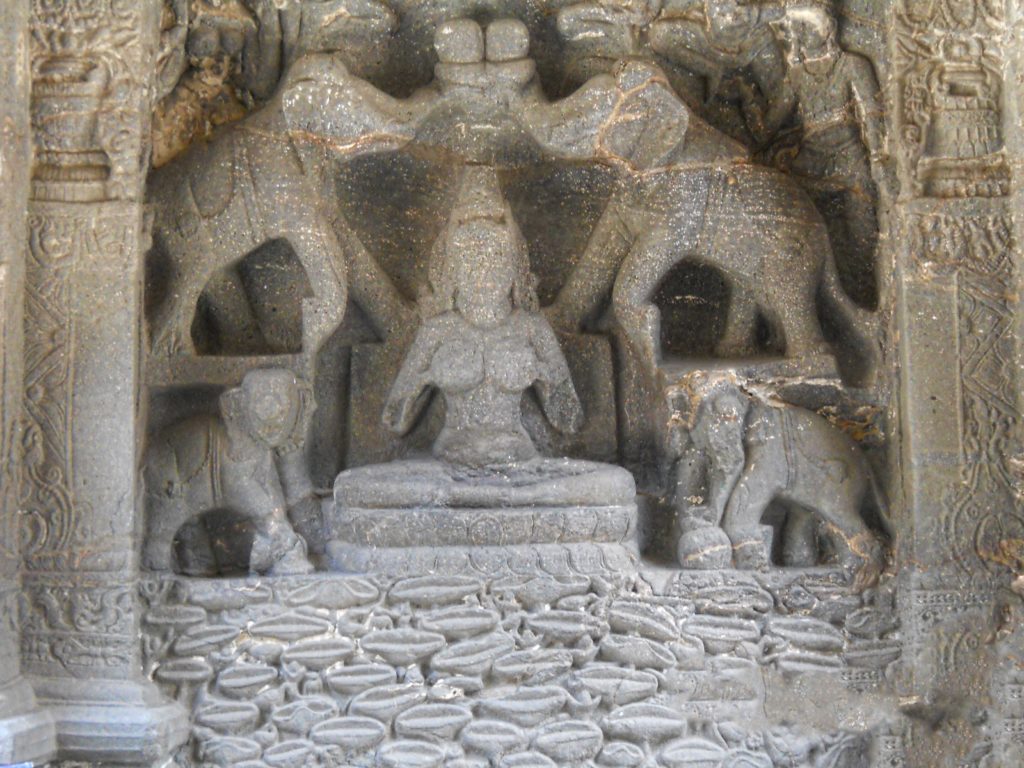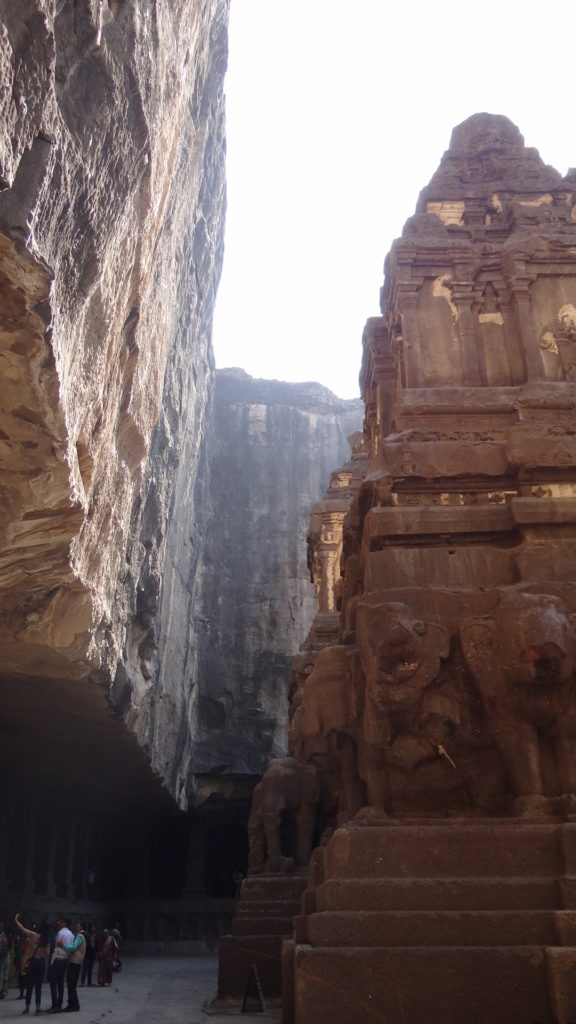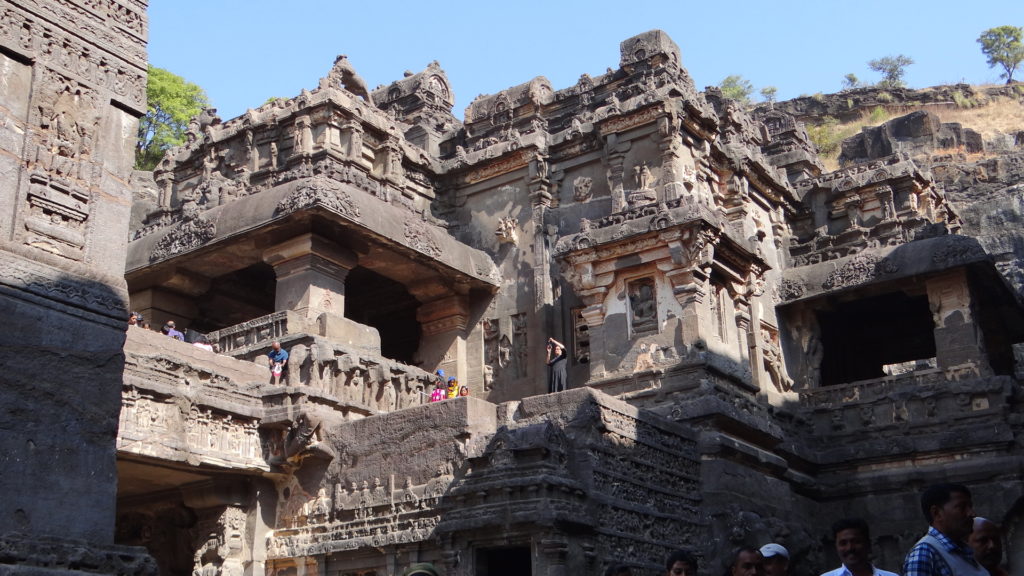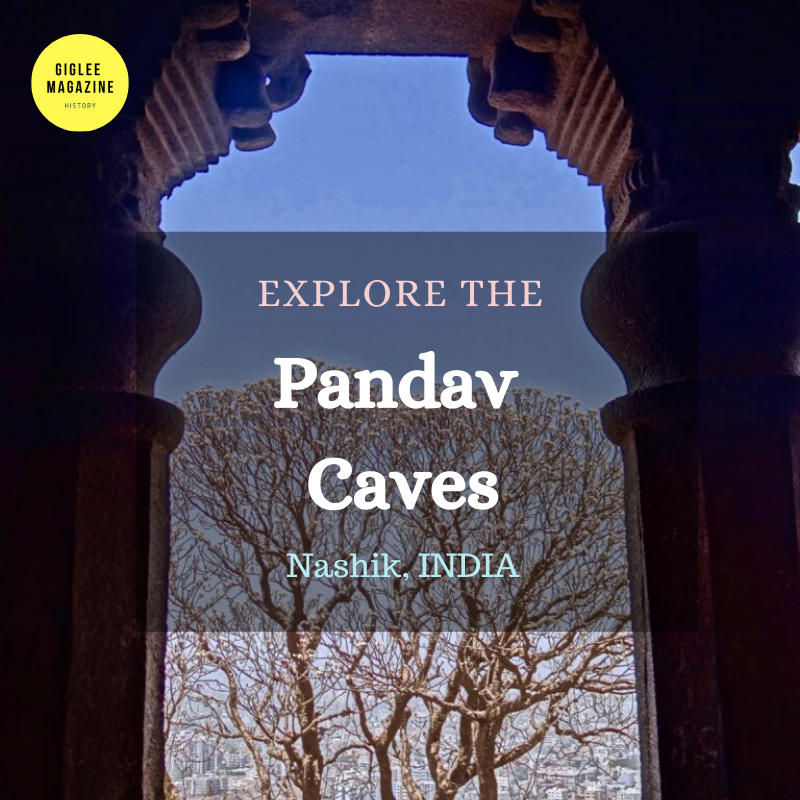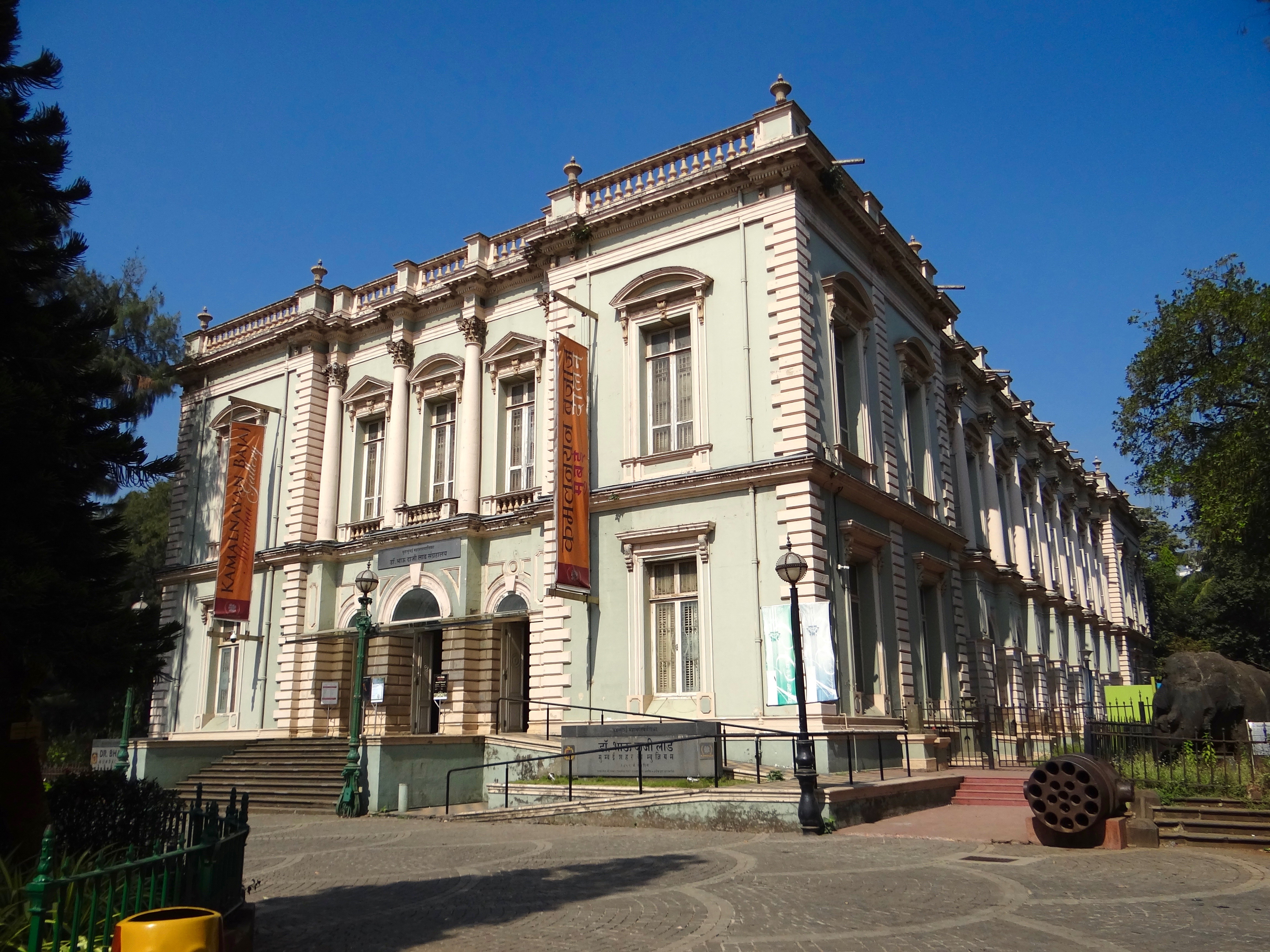
Dispelling Rumours about the Kailash Temple, Maharashtra
The Cave No.16 at Ellora has been the source for many intriguing tales, which amongst them speak the truth?
Watch this
Listen to this
It was on an amiable day in December that I found myself in one of the world’s most mystic Hindu temples. I was one amongst many, surrounded by throngs of tourists jostling past me to enter through an ancient gateway, Gopura.
What were so many Indians doing here? Enjoying the pleasant December weather or spending a few peaceful days with family? Is family really ever peaceful?
These wayward thoughts came to an abrupt halt at the novelty that stood before my eyes. Its form made me aware of how small I was. The humongous mountain dwarfed the temple, a gem cradled in its arms. And in front of this temple stood I, gawking at what my ancestors created.
The Kailash temple, Maharashtra is the spotlight of every tourist’s visit to Ellora.
This temple has been a part of many a person’s wildest imagination and featured in a few extraterrestrial websites. I like to describe this temple as an open book with a distinct whiff of secrets.
Just standing here, it makes every person wonder, is this the work of the Lord himself or something conceived by a novice human mind?
On second thought, to conceive big dreams might be easy for us mortals but shaping these dreams into reality is the work of the experts.
Were those sculptors truly consummate disciples of art? So well versed in their talent that their craft surpassed all expectations and fuelled the imagination of the generations to come?
All these are indeed very difficult questions, their answers equally enigmatic and debatable. In this article, let us put facts into lucid words as we explore the mysterious Kailash Cave Temple.
One learned scholar in Indian architecture, Mr.James Burgess describes the Kailash as,”One of the most remarkable of all the cave temples in India.”
In two of his books, Mr.Burgess and his colleague Mr.James Fergusson describe, to their best ability, the Cave No.16 at Ellora. Their preliminary study of this cave complex have inspired a few thesis, books and heated debates.
This makes you wonder what this anomaly is, that makes every person look twice in its direction. What is this temple of Lord Shiva like?
For the eyes of an amateur, the Kailash Temple, Maharashtra is just a temple of Shiva with the customary Nandi facing the Shivling.
For an enthusiast, it holds many secrets, a few as much a fact as the bright sun.
The Kailash Cave temple is built in the Dravidian style of architecture. This style is famous in the south of India, making Kailash a recluse when it comes to its inconvenient location in the north-central part of the subcontinent.
The Kailash Temple, scholars believe is the farthest temple from the south of India adorned in a Dravidian style.
How can this temple be characterised so?
It is the two storied gateway called the Gopura that gives this fact away.
This Gopura is a hint into what lies behind, a temple initially out of site for a short human. The Gopura is flanked by many significant deities and creatures from the Hindu mythology.
Once inside, the energy, the motion along with the contrasting calmness hits you. There is an idol of Shiva, worked up into a vigorous Kal Bhairav and on the other side, Shiva as calm as the Mahayogi.
On either side of the temple are huge larger than life elephants with a Dhwaj Stambh (a pillar, see the picture below) each. These monolithic pillars seem to hold a 4 feet tall Trishul or the Trident of Shiva, almost destroyed by the centuries.
And the main temple, crowded by hordes of raptured tourists, is like a bejewelled Queen.
The plethora of carvings in the temples are what shatter the calmness. The hundreds of monsoons and the harsh sun have almost emerged victorious but they haven’t squashed the essence of these many stories etched on the walls of the Kailash temple, Maharashtra.
The herd of elephants that surround the shrine’s plinth, were once mighty. Despite their missing trunks and dilapidated bodies, you can almost feel the elephants physically pouncing on you. When you wrench your gaze away from these mammals and look up, the glorious Shikhara rises as if connected to the blue sky.
A few fragments of paint survive on the exterior carvings, almost missable by an unobservant eye. It is no wonder the Kailash is also called the Rang Mahal. There are more specimens of this old paint in the Mukha Mandap (the main shrine).
The sanctum unlike many others is not on the ground floor. It is elevated and only accessible by an unsteady flight of stairs. As you make your way to the first floor, praying for the safety of your limbs, the view from the Mukha Mandap’s porch is purely mesmerising.
The exteriors seem to be a mere precursor into the ornate work that lies hidden behind a curtain of darkness and shadow, within the temple.
The columns have been beautifully and laboriously carved as if from the inside out. It is indeed very hard to remember they are carved from the same rock.
The interiors are in pitch darkness, as they have been for centuries. That is what has kept the masterpieces within it safe. The thousands of years old paint can be admired here, on the ceiling and on the walls. At the eastern end, is the plain Lingam, the most treasured part of the temple.
On either side of the Garbagriha (the room where the idol of God or in this case the Lingam is placed), are doors that lead onto the terrace with five smaller cubicles topped by a Shikhar (the peak-like architecture) each. Out of these five structures, four have a pedestal each, perhaps to place the idol of God. They are now empty but for the work done on them.
For a devotee this terrace is a means to perform Pradakshina, the holy circumambulation around the idol of God after prayer. It is also a nice viewing platform to catch an almost 360 aerial view of the Kailash Temple.
The solid mountainous rock that seems to emanate its magnificence with its sheer size, itself has a few caves and an ambulatory (a covered passage) on the rear and either sides of the temple.
This rich temple, not in monetary terms but in its artistic sense is the work of legends.
How then was it built? What is the Kailash temple’s story?
The History
The story of the Kailash is uncertain. It is unfortunately a common, and a frustrating element of Indian history. As Nehru mentioned in his book, Discovery of India, documentation is a missing part of India’s past. The unfathomable beauty India holds, is often shrouded in uncertainty and its architect forgotten.
Thus, a few scholars have put their heads together, working on fragments of evidence and justified a story. The others have clashed their heads time and again. Thus we have been left with not one but three interesting versions of the temple’s history.
Version 1
The first and what seems to be an unproven tale is that of the Queen Manikavati of Achalapura. The story tells us the King of Achalapura, the second most populated city in Amravati (refer the map), suffered from a strange illness. He would fall sick after dusk and return to his healthy self in the morning.
When the Royal duo visited the ancient city of Ellapura, as Ellora was called, the King took a holy dip here. His Queen prayed to Lord Shiva for her husband to recover from this bizarre sickness. In exchange she promised, she’d build the Lord a temple and not eat a single food grain till the temple’s Shikara was completed.
The King’s illness did indeed recover and as promised, Queen Manikavati asked her husband to commission a temple. The King searched for an architect who would in a span of a week build at least the Shikhara of the temple. This would save his wife from fasting to death.
The architect named Kokasa said he could take up the challenge. And indeed he crafted the Shikhara within a week, solving the Royal issue. This temple was then named after the Queen as Manikeshwar Temple. A few centuries later, this temple was named Kailash, after the mountain in the Himalayas where Shiva is said to reside.
This story thus suggests that the Kailash temple is not just older than what most people believe it to be, but also the oldest cave to be built in the Ellora cave complex
To the educated and scientific mind, this theory seems the least likely. However there are indeed a few scrolls discovered from ancient and medieval India, that state the Rashtrakuta King Krishna I’s astonished interjection on seeing the Kailash temple for the first time. These scrolls are the only pieces of written evidence that render the following two versions of history as just theories.
Version 2
The theory proposed by the German Scholar H Goetz and a few others suggest the Kailash Temple, Maharashtra was built over many centuries, at least by eight generations of Kings. Mr.Goetz also goes on to suggest Ahilyabai Holkar in the 19th century added her own contribution.
Apart from this arguable statement, this version of history says like Rome, Kailash was not built in a day or in a lifetime. It was built in a span of 80-100 years or by 7 Rashtrakuta and 1 Pratihara King from the 8th to the 13th century.
Some evidence might suggest that a few parts of the Kailash temple sanctuary are indeed newer additions and not a part of the original plan.
Version 3
The third version is in line with the one proposed by the German scholar.
Other experts on the Kailash temple have justified logically that the temple could have been constructed in a span of 10-20 years. I shall explain how subsequently.
This theory says that the first Rashtrakuta King, Dantidurga designed the Kailash and built it himself. His uncle who succeeded him, Krishna I then just completed the unfinished parts. This theory might even explain Krishna I’s reaction on seeing the Kailash temple for the first time.
It might also explain why certain parts of the Kailash temple are newer than the rest.
Of course these three stories are not the only versions out there. There are a few that run on similar lines and the rest are at unhinged tangents. I found these bunch of theories something to ponder on, the rest were just fiction.
Which one do you think is a plausible answer? Or do you have your own version to share? Comment below under this post to start discussing!
If you still need more information or time to digest these theories, let us hop on to the most intriguing part of this article, the construction of this monolithic beauty.
Constructing the Kailash Temple, Maharashtra
Yet again there seem to be a couple of opinions with slight changes on the method applied to construct. I have tried to piece them together for you.
This task of crafting the Kailash Cave Temple was a mammoth one. It was a task that required a Six Sigma precision and a very articulate plan.
They began by finding a slab of the mountain strong enough and shaped as close to the temple plan as possible. They then demarcated the lines to make sure the temple was according to the plan, in lieu with the planned scale and arrangement.
According to these lines, they seem to have constructed a gully that was either a naturally eroded part on the surface of the mountain or one they made themselves for the purpose of construction. This gully ran across the edge of the planned construction area.
They would transport materials and men from here to the back of the temple where the construction is deemed to have begun.
To bring any idea to life, it is customary to break it down into smaller achievable tasks.
The construction plan thus broke it down to three phases. The first phase was where the Shikhara stands. The second was the one in the centre, just before the Nandi and the last was the entrance along with the immediate facade of the temple.
The edge of the mountain, where the outer court in front of the entrance now is, was harried into a flat platform to make the access easier for the devotees and the workers themselves.
How then did they bully the rock into becoming a bejewelled piece of a chef d’oeuvre?
Even though they had only a hammer to disperse the unwanted rock, almost 200 tonnes of it, they had what humans have forgotten, an ingenious technique.
Explained in the book titled Kailasa–The Stylistic Development and Chronology, the technique was a well established one developed through simple physics.
The weaker parts of the rock were first identified. A line was drilled into the rock along with small incisions in brisk linear pattern which looked like angry slashes of paws. This would considerably weaken the rock. Then one person, wielding his hammer along with a bucketful of frustration struck the drilled incision. The entire chunk of rock would fall apart at a right angle to the main mountain. This might be why the mountain’s walls surrounding the Kailash are so smooth and straight.
The big chunks of rock would then be hammered into smaller pieces and removed from the construction site. If 250 people worked on dispelling 4 feet of rock each day, it would take them about 5 and a half years.
This technique and the overall plan tells us that whoever constructed this temple had a deep knowledge of the architectural principle of massing and of geometrical measuring.
This ingenious method to remove the unwanted rock left the remanent parts looking like the overall shape of the temple. What about its details?
Herein lies another disagreement.
One scholar asserts this temple was first excavated as a very crude overall structure and then hammered into its beautiful shape. The other suggestion is that the temple was crafted into shape as soon as a piece of excess rock was hammered out.
The second theory might make it very cumbersome to stick to a perfect symmetry and thus the entire plan. It requires a lot of simulation, imagination and a huge room for error. And due to the plan and the limited raw materials, a mistake was out of question.
What scholars do agree on is that they used a top to bottom approach in sculpting the exterior as well as the interior of the Kailash cave temple.
The two elephants, the pillars, the main temple, its Nandi and the Gopura seem to be a part of the original plan.
As for the paint, it is uncertain whether they painted the temple just then or it was the work of a monarch in the later years.
The carvings at this temple hint at a very skilled hand though.
In the 8th century, there seemed to have been a class of artists who were either forced or on their own accord, moved from one construction site to another.
The Kailash temple is compared to the Virupaksha temple in Pattadakal (refer to the map) for the Mahabharata and Ramayana reliefs that it has and the overall structure. This likeness can only be crafted by the same set of artists.
At Kailash there seems to be a fusion of a multiple styles. Some have been made by the Chalukyan artists and the other Rasktrakuta.
The Rashtrakuta artists had perfected the female form, as can be seen from the myriad depictions on the walls at Kailash. The artists in Maharashtra, a medieval text states, were skilled artists too.
A bridge is said to have joined a veranda from the main shrine to the adjoining cave in the left of the temple. This bridge collapsed just 30 to 40 years after the temple was completed. It didn’t damage much of the surrounding monuments and seems to have given way to a beautiful carving under it. A carving crafted to catch the perfect angle of the light and give it a more dramatic effect.
The ambulatory (a covered passage) behind and to the either side of the main temple was added as an after thought as well as a few parts of the Lankeshwar Temple located in the Kailash temple’s premise.
“Kailasa must always remain a miracle of patient industry applied to a well defined purpose,”
James Burgess and James Fergusson
The Lankeshwara Temple
The Lankeshawara Temple partly looks to be a younger cave than that of the Kailash. This temple sits adjacent to the Kailash temple, hidden within the mountain.
I hadn’t heard of this temple during my visit, and since I had decided to shy away from the crowds, I didn’t visit it. It thus makes it almost impossible for me to describe this temple to you.
My research tells us that there are 27 massive pillars here. These pillars are similar to the ones at the Mandap’s assembly area but unique in their own right.
The central and cross aisles are larger than those at the main temple which gives this temple a light and fresh view. However the state of the carvings leaves almost nothing to be appreciated since they lie in a pitiable state, dilapidated.
This dilapidated state of the statues at Kailash might not have just been the brutal effects of time but also that of a few cruel invaders. Alauddin Khilji, in the 13th century moved his court to Daulatabad in Aurangabad. He might have tried to destroy this Hindu temple. If not for him, the Mughal emperor Aurangazeb after whom the town of Aurangabad is named, might have tried to raze this temple to the ground in 1684. Legend suggests, the temple couldn’t heave to his pressure and thus Aurangzeb finally gave up leaving behind just a few scratches.
Whatever the current state of this temple cave may be, we might never call it the work of an amateur. When James Burgess and James Fergusson stated, “Kailasa must always remain a miracle of patient industry applied to a well defined purpose,” they weren’t wrong at all. In fact this sheer patience and persistent work is something each of us should learn from and appreciate.
It was with equal appreciation and twinkling eyes that I left the Kailash cave temple and boarded the bus for the parking lot. It had been a wish of mine for almost 6 years to return to this cave. A cave I had regretted not visiting during my initial trip to Aurangabad. The Kailash cave gave me a sense of satisfaction and a burning curiosity for the ingenious ‘shilpi’ who designed it.
A temple that shall forever haunt my imagination and that of others that come after me.
I’ve tried to make this article as succinct as possible for those of you who do not have a detailed know-how about the Indian temple architecture and the country’s geography in general. If you have any questions, drop them in the comments below and I shall respond.
Also do sign up for weekly updates (Saturdays) when I publish a new article
If you liked reading ‘Dispelling Rumours about the Kailash Cave Temple’, please share it with your friends. And of course don’t leave just yet. There’s more to read. You might like these articles as well
Conquering the Daulatabad Fort in Aurangabad
Living History in All its Glory: Hampi
The fascinating Caves in Nashik, a few hours ride from Aurangabad: Pandavleni
Bibliography for Kailash Temple Maharashtra
Kailasa – The Stylistic Development and Chronology: MK Dhavilikar
The Date of Ellora’s Kailasa Cave-Temple: Vedveer Arya
The Cave Temples of India: James Fergusson and James Burgess
The Kailāsa of Ellora and the Chronology of Rāshtrakūta Art: H Goetz
Ellora Concept and Style: Carmel Berkson





